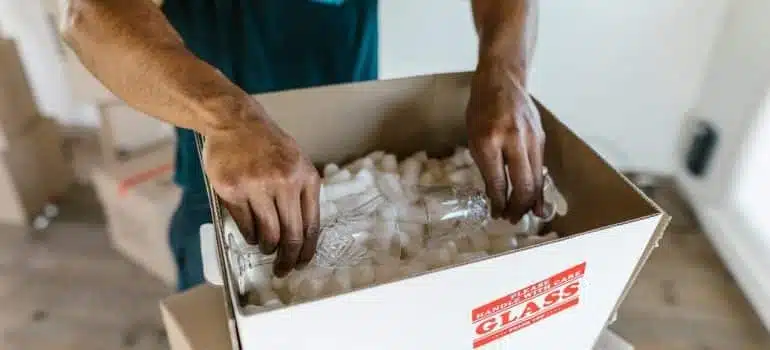5 Steps to packing your dining room for a move
Glassware chips. Chairs wobble. Tables scratch. Packing your dining room for relocation takes more than tape and boxes. It’s where bulky meets breakable, and every item needs its own plan. Our Pro Movers Miami prep guide gives you clear steps for packing your dining room for a move, from disassembling the dining table to boxing up linens and serving tools.
1. Declutter and organize before packing your dining room for a move
Before any boxes come out, take time to clear the space and sort through everything. Dining rooms hold a mix of fragile items, heavy furniture, and storage pieces that need careful handling. Getting organized now prevents damage and saves time later.
Clear surfaces and storage areas
Start by emptying the dining table, china cabinet, sideboard, and any drawers. Place items on a large, flat surface so you can see what needs to be packed. Sort by type—glassware, plates, flatware, linens, and décor.
Remove what you won’t move
Go through each group and decide what to keep. Broken plates, duplicate serving dishes, or outdated décor often aren’t worth the box space. Set these items aside to donate or toss. Cutting down now makes packing your dining room for a move faster and less expensive.

Clean and prep what stays
Make sure everything is clean and dry. Dishware should be washed, flatware wiped, and linens folded. Damp items can lead to stains or mold, especially during long transport or storage. Glass pieces and fragile items should be set aside for extra care.
2. Disassemble and protect your table correctly
Dining tables are heavy, often expensive, and easily damaged if packed the wrong way. Disassembling them early when packing dining room makes moving easier and helps protect surfaces from scratches, dents, or cracks.
Take the table apart if possible
Start by flipping the table gently onto a blanket or soft surface. Remove the legs, extensions, or glass inserts using the right tools. Keep all hardware in a sealed, labeled bag and tape it securely to the underside of the tabletop or store it in a clearly marked box.
Wrap and secure each piece
Always prepare and use suitable packing supplies. Padded blankets or thick moving wrap will protect the tabletop and legs well. Don’t let tape or plastic touch finished wood directly. Stretch film can hold padding in place, but soft fabric between layers adds extra protection. If you’re wondering how to pack a dining room table without damage, this combination works well for most materials.
Prevent surface damage in transit
Try to avoid typical packing mistakes like stacking anything on the wrapped tabletop when packing your dining room for a move. You’d especially want to prevent scratches on dining table during loading and unloading. Wood surfaces are prone to pressure dents, and even soft items can leave marks during transport. For high-gloss finishes, placing felt pads between layers adds another layer of protection.
3. Wrap and protect your dining room chairs
Chairs often take more damage during a move than people expect. Their legs can crack, corners get scuffed, and fabric tears if not wrapped well. Proper protection keeps them stable in the truck and makes unpacking easier.
Check each chair for loose parts
Before wrapping, inspect every chair. Tighten any loose screws or joints. If cushions or legs are removable, take them off and label the parts. Stackable chairs should be kept in pairs—not high stacks—to avoid pressure damage.
Wrap with care using soft materials
Start by covering each chair with a padded blanket or thick wrap. Secure the covering with stretch film or tape, avoiding direct contact with wood or fabric. Use towels or foam pieces for added protection around arms or carved areas. Taking this extra step is especially helpful when packing dining room chairs with delicate finishes.

Position safely in the moving truck
Place wrapped chairs upright between sturdy items. Avoid stacking boxes on top or pressing chairs against hard surfaces. Even slight shifting during transport can cause damage. Proper positioning reduces the risk of breaks, scuffs, and shifting while on the road.
4. Secure fragile storage pieces like hutches and buffets
Large furniture pieces with glass doors or shelving need special care when moving. Buffets and hutches can shift during loading, and their delicate parts are easy to overlook. Good preparation reduces the risk of breakage or scuffing.
Empty and prepare each section
Remove everything inside: glassware, shelves, decorations, and hardware. Loose items inside cabinets often shift and cause damage. To prevent chips or cracks, take extra care when packing fragile glass, using proper wrapping and sturdy boxes. If shelves are detachable, take them out and label them so they’re easy to reassemble. Wipe down all surfaces and check for hidden pieces or fragile parts.
Protect the outside carefully
Wrap the entire piece using padded blankets, with extra layers on glass sections and corners. Secure the padding with stretch film or straps. Avoid placing tape directly on wood or glass. If the furniture has fragile detailing, soft cloth can cushion exposed areas.
Prevent movement during transport
Doors and drawers should stay closed during the move. You can tape them shut or remove them if needed. Use clear visual markers to avoid confusion during handling:
- “Fragile” stickers on glass-facing sides
- “This Side Up” arrows on both ends
- Painter’s tape in an X across the glass panels
- Color tags to flag pieces that need extra care
Also, keep all screws or knobs in labeled bags. When placing these items in the truck, surround them with soft padding and keep them upright.

5. Pack small dining items and label boxes clearly
The final part of packing dining room for a move involves handling smaller items like serving tools, lightweight trays, and decorative accents. These may not take up much space, but they can still get damaged or lost if packed carelessly.
Sort items by type and pack them in small or medium boxes to avoid shifting. Wrap anything breakable in paper or cloth. Sharp or awkward shapes should be cushioned with packing peanuts to prevent damage. Don’t overfill boxes. Lighter loads are easier to carry and safer for delicate contents.
Common items in this final stage include:
- Serving utensils and small trays
- Decorative pieces like candleholders or vases
- Loose hardware, screws, or chair pads
- Instruction manuals or furniture tags
Label each box clearly with its contents and destination room. Mark fragile boxes and note anything that should be unpacked early. Taking time now to label properly will save effort and confusion later.
Pack your dining room with care and avoid damage
Packing your dining room for a move takes more than just boxes and tape. First, sort everything by type. Then, wrap each piece carefully and use proper padding. After that, label every box clearly. In the end, good planning and reputable antique movers save time, prevent damage during transit, and make unpacking faster and more manageable in your new home.
